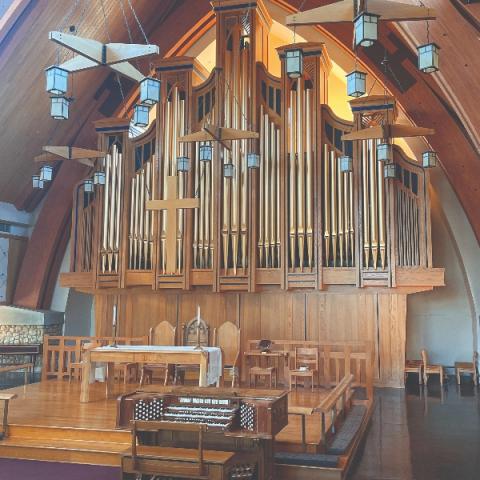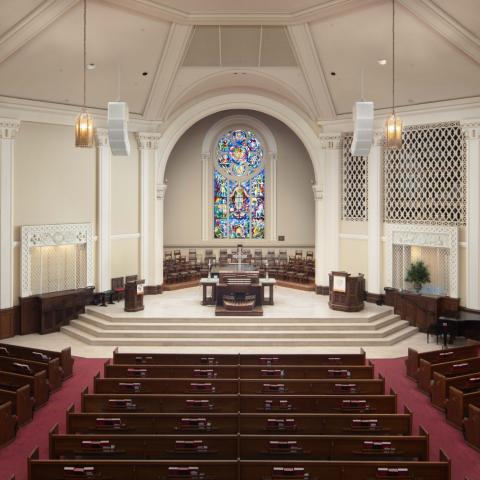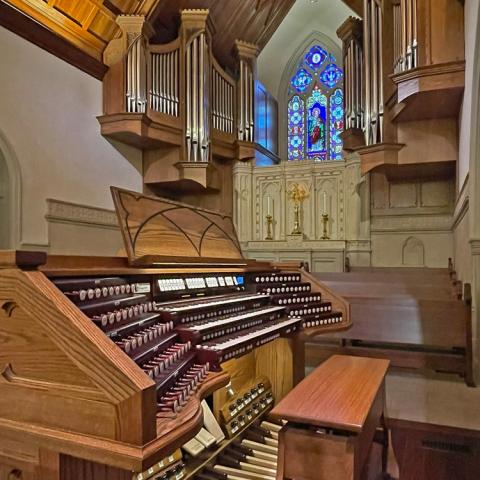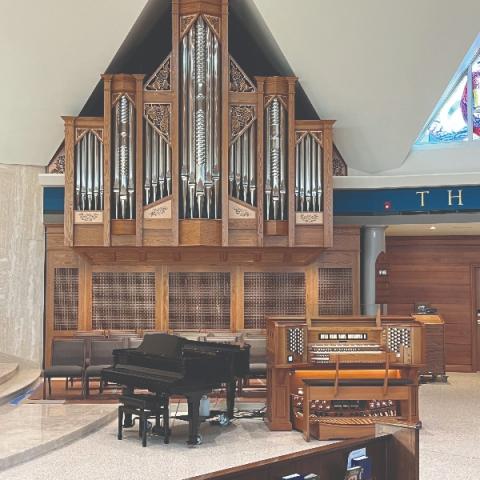Rosales Organ Builders, Los Angeles, California, Opus 42; Parsons Pipe Organ Builders, Canandaigua, New York, Opus 51; St. James by-the-Sea Episcopal Church, La Jolla, California

In any artistic endeavor, the goals of the artist guide every step of the process to achieve his desired result. When multiple artists collaborate, the result can be a wonderful synergy of goals, something that a single artist would not have created on his own. The new organ at Saint James by-the-Sea in La Jolla, California, is a wonderful synergy of multiple artists working together to create something quite special and unique.
Church building and history
The current sanctuary of Saint James by-the-Sea seats about 450 and was finished in 1930. It is built in the Spanish Colonial style with walls of poured concrete and a wooden ceiling 33 feet above the floor at the peak. This provides a pleasant acoustic, especially for small ensembles and choirs, although the ceiling height and material limit reverberation. The building was finished during the Great Depression, when money was tight limiting the size of the organ installed by Henry Pilcher’s Sons. At three manuals and 33 stops, it is unlikely that the Pilcher filled the two large organ chambers on either side of the chancel. The four-manual Austin that replaced it in 1975 filled only three-quarters of the chamber space. Austin Organs, Inc., Opus 2585 was a major pendulum swing away from the Pilcher in terms of style, and it shared many characteristics with other organs of that era. Although the stoplist was not as top heavy as some other instruments of the day (each division had at least one 8′ open flue stop), the scaling provided weak bass tones, and the voicing style emphasized the upper harmonics. The room acoustics were a major contributor to the weak bass, small-scaled bass pipes did nothing to counteract this. The Great and Positiv divisions were placed in four flower box displays, two on either side of the chancel. These displays were located in front of four chamber openings that limited how much sound could escape the chambers behind. A sizable Antiphonal division hung on the back wall below a round window.
Project history
Our participation in the project in La Jolla began in early 2018 when director of music Alex Benestelli contacted Manuel Rosales about rebuilding the existing organ at Saint James. Thomas Sheehan, who currently serves as organist and associate director of music at Washington National Cathedral, had been hired by Saint James as organ consultant. Parsons was invited to collaborate with Rosales in presenting a proposal. Through many discussions, it was decided that rather than rebuild the failing Austin mechanisms, we would provide a new mechanical chassis along with new casework and many new pipes. Some pipes from the Austin would be retained as they would provide useful voices in our new tonal scheme.
A letter of intent was signed in October 2018, and following presentation of a façade rendering, the contract was signed in September 2019. Because of electrical issues with the Austin, it was decided to remove the organ sooner rather than later, and this was done in January 2020. With the organ removed, the church could prepare the chambers to receive the new instrument. The four new cases that hang on the chancel walls are taller and heavier than the previous flower box cases, requiring new steel structure to be engineered and installed. The Antiphonal could occupy the existing steel structure, although this would need to be stiffened to meet current codes even though the division was being reduced to a solo reed and a unit Principal.
We collaborated with MDEP of La Jolla, who engineered steel frames that would hold the organ and allow maximum access for service. MDEP received the 2023 Award for Historic Preservation from the Structural Engineers Association of San Diego for their work on the Saint James organ project. The existing chancel concrete openings were enlarged to improve tonal egress and service access to the mechanisms located in the cases. The ceilings of the organ chambers were also thickened with added material to promote tonal projection.
Organ case
The four chancel cases and Antiphonal case are constructed of quarter-sawn white oak and stained to complement the church furnishings. Multiple elements from the church architecture are echoed and tied together in the cases. These include the seashell and sword that are symbols of Saint James. These elements along with the wooden grillework and columns were all fabricated on our CNC router. Façade pipes from the 16′ and 8′ Diapasons on the Great and Pedal and the 8′ Principal in the Antiphonal are of 80% tin and are polished with a fine abrasive to mute the reflectiveness of the pipes. Pipe mouths and some case elements are covered with gold leaf to help warm the color palette of the organ.
Tonal design
The goal of the tonal design of the new instrument is to accompany choral anthems and congregational singing. This encouraged a design including many color stops, a large majority of which are under expression. In the end a total of 59 ranks are under expression in three enclosures. Thirty-three stops are of 8′ pitch, and sixteen of the ranks are reed pipes. Only one reed, the nautically themed Tromba Marina, is located outside of an expression box above the west door in the Antiphonal. Voicing of all flue pipework was completed by Duane Prill, and reeds were voiced by Chris Broome and David Schopp. In turn these pipes were tonal finished in the church by Manuel Rosales with assistance from the Parsons staff.
The chamber on the south side of the chancel contains the three principal manual divisions: Great, Swell, and Choir. The Great is divided into two sections: the first Principal chorus based on 16′ pitch is unenclosed in one of the four new chancel cases. The remainder of the Great is enclosed with the Choir including the independent Tromba chorus on ten inches of wind. The Choir contains many color stops including a full complement of mutation stops. The large Swell division is located behind the Unenclosed Great and contains all of the expected stops for accompanying choral literature.
The north side of the chancel contains the Pedal and Solo divisions. In part, this was due to the fact that the floor was eighteen inches lower on this side, so there was more ceiling height available for the taller bass pipes. In spite of this, the longest wooden pipes of the 16′ Open Diapason and the Haskelled 32′ Contrebasse had to be laid down along the back wall of the chamber. All of the wood pipes of these two stops as well as the bass octaves of the Swell and Great flutes were built in our shop. The 32′ Contra Bombarde is located in the Solo expression chamber and is a commanding voice on 17.5 inches of wind. However, the expression shades allow it to be closed down and used with a much wider variety of manual stops.
Mechanical design
Because this was a collaboration, the mechanical design required careful management of the process in terms of pipe materials, scales, winding, chest designs, and even racking methods. The majority of the pipework stands on slider and tone channel windchests. The pallets are provided with pneumatic assists (balanciers) to improve action speed and repetition. The remainder of the stops play from all-electric or electro-pneumatic chests. In order to create the wide variety of colors in the tonal design, a wide range of wind pressures were necessary, ranging from 2.75 inches for the Antiphonal Principal to 17.5 inches for the Tuba and 32′ Contra Bombarde. Wind is provided by five blowers in three locations totalling 13.5 HP. The blowers feed sixteen reservoirs of different constructions including bag bellows and single-rise regulators with both cone and curtain valves to serve specific purposes throughout the organ. Numerous concussion bellows smooth out unwanted ripples in the wind and are disengaged when the tremulants are active.
Whenever we design a new instrument, we always strive to make the design as serviceable as possible. Our philosophy is simple: if an organ is easy to service, it is more likely that it will be maintained and indeed serve the church for hundreds of years. This drives every layout decision and suggests where we might add additional ladders or make a part more easily removable if there is something behind it that might need service. We have encountered many organs where this was not given consideration, and major sections of the organ need to be removed in order to make small adjustments or repairs. This was an extraordinary challenge at Saint James because the organ we were installing was larger and contained more 16′, 8′ (and even 32′) stops than existed in the previous instruments. The scales of the pipes we were installing were also larger, which consumed a significant amount of space. Through careful layout, it is possible to navigate through the organ and adjust the mechanism as needed. Many hinged walkboards and ladders provide service access to mechanisms. Extra ladders and perchboards are provided to reach pipes that are tall or hanging from the ceiling or just simply harder to access.
Console
The new movable four-manual console is built of quarter-sawn white oak and stained to match the new cases. The interior wood is cherry with accents in African padauk. It was designed to be as low-profile as possible with a drop-sill keydesk. Manual naturals are covered in bleached bone with sharps of African blackwood as are the custom drawknobs. The side panels on both ends of the console are doors that open to reveal storage cabinets for the organist and organ technician. Two music racks are provided: a decorative wood rack with book-matched madrone burl, and a clear scratch-resistant polycarbonate rack for improved visibility. The control system by Opus-Two handles the myriad of complex functions available to control the instrument, including Sostenuto, melody coupling, through-coupling, transposer, and record/playback. The system includes 1,000 assignable folders, each with 250 levels of memory.
The initial installation began in June 2022. Components from the five cases, the Antiphonal and the north side organ chamber containing Pedal and Solo stops completely covered the nave and parish hall. Two more phases of installation followed, with tonal finishing beginning in February 2023. Staggering the installation process allowed the three tractor-trailer loads of organ to be safely and efficiently unloaded and organized in the church’s small sanctuary. Much of the organ was complete and playing in time for Easter, and the organ was officially accepted on July 23, the Feast of Saint James. The organ will be dedicated October 1, 2023, with a concert by Ken Cowan, which will kick off a year of festivities to celebrate the new organ. It now begins its life in service to the church of Saint James by-the-Sea, truly a unique instrument and the fruit of the labors of many artists.
—Peter Geise, Technical Director
Parsons Pipe Organ Builders
Parsons Pipe Organ Builders website: parsonsorgans.com
Rosales Organ Builders website: rosales.com
Saint James by-the-Sea Church website: sjbts.org
Photo credit: Ron Belanger
GREAT (Manual II, unenclosed; * enclosed with Choir)
16′ Double Diapason 56 pipes (low F, façade)
16′ Violone (Austin) * 61 pipes
8′ First Diapason (façade) 61 pipes
8′ Second Diapason * 61 pipes
8′ Flûte harmonique * 61 pipes
8′ Bourdon * 61 pipes
8′ Violoncello (ext 16′) * 12 pipes 4′ First Octave 61 pipes
4′ Second Octave * 61 pipes
4′ Spire Flute * 61 pipes
2-2⁄3′ Octave Quint 61 pipes
2′ Super Octave 61 pipes
1-3⁄5′ Tierce 54 pipes
Fourniture IV–V 281 pipes
16′ Contra Tromba * 61 pipes (high pressure)
8′ Tromba (high pressure) * 61 pipes
4′ Tromba Clarion* 61 pipes (high pressure)
Tremulant
8′ Tuba Mirabilis (Solo)
Chimes (Walker)
SWELL (Manual III, enclosed)
16′ Lieblich Gedeckt (Austin) 61 pipes 8′ Geigen Principal 61 pipes
8′ Rohrflöte 61 pipes
8′ Viole de gambe 61 pipes
8′ Voix céleste 61 pipes
8′ Flûte douce 61 pipes (Aeolian-Skinner)
8′ Flûte céleste (TC) 49 pipes (Aeolian-Skinner)
4′ Principal 61 pipes
4′ Flûte traversière 61 pipes
2′ Octavin 61 pipes
Plein Jeu IV–V 281 pipes
16′ Contra Bassoon 61 pipes
8′ Trumpet 61 pipes
8′ Bassoon (ext 16′) 12 pipes
8′ Oboe 61 pipes
8′ Vox Humana (Gottfried) 61 pipes
4′ Clarion 61 pipes
Tremulant
CHOIR (Manual I, enclosed)
16′ Erzähler (ext 8′) 12 pipes
8′ Open Diapason 61 pipes
8′ Gedeckt (Austin) 61 pipes
8′ Erzähler (Austin) 61 pipes
8′ Erzähler Celeste 49 pipes (TC, Austin)
4′ Principal 61 pipes
4′ Koppelflöte (M. P. Möller) 61 pipes
2-2⁄3′ Nazard (Austin) 61 pipes
2′ Octave 61 pipes
2′ Blockflöte (Austin) 61 pipes
1-3⁄5′ Tierce (Austin) 54 pipes
1-1⁄3′ Larigot (Austin) 61 pipes
Mixture III 183 pipes
16′ Bass Clarinet (ext 8′) 12 pipes
8′ Trompette 61 pipes
8′ Corno d’Amore 61 pipes (E. M. Skinner & Son)
8′ Clarinet 61 pipes
Tremulant
8′ Tuba Mirabilis (Solo)
8′ Tromba Marina (Antiphonal)
Great Reeds on Choir
SOLO (Manual IV, enclosed)
8′ Doppelflöte (Wicks) 61 pipes
8′ Concert Flute (vintage) 61 pipes
8′ Gamba 61 pipes
8′ Gamba Celeste 61 pipes
4′ Hohlpfeife (Austin) 61 pipes
Cornet V (TF, mounted) 195 pipes
8′ French Horn (Casavant) 61 pipes
8′ English Horn 61 pipes
Tremulant
8′ Tuba Mirabilis 73 pipes
8′ Tromba Marina (Antiphonal)
Great Reeds on Solo
8′ Harp (Walker)
8′ Orchestral bells (Walker)
4′ Celesta (Walker)
Tower Chimes (existing Deagan)
PEDAL (Unenclosed; * enclosed with Solo)
32′ Contrebasse 32 pipes
32′ Bourdon (Walker)
16′ Open Diapason (façade) 32 pipes
16′ Contrebasse (ext 32′) 12 pipes
16′ Bourdon (Austin) 32 pipes
16′ Violone (Great)
16′ Lieblich Gedeckt (Swell)
16′ Erzähler (Choir)
10-2⁄3′ Quint (Smart Quint)
8′ Flute (ext 32′) 12 pipes
8′ Octave (façade) 32 pipes
8′ Open Diapason (ext 16′) 12 pipes
8′ Bourdon (ext 16′) 12 pipes
8′ Violoncello (Great)
8′ Lieblich Gedeckt (Swell)
4′ Choral Bass 32 pipes
4′ Bourdon (ext 16′) 12 pipes
32′ Contra Bombarde * 32 pipes (full length)
16′ Bombarde * (ext 32′) 12 pipes
16′ Tromba (Great)
16′ Bassoon (Swell)
8′ Trumpet* (ext 32′) 12 pipes
8′ Tromba (Great)
8′ Bassoon (Swell)
4′ Clarion * (ext 32′) 12 pipes
4′ Tromba Clarion (Great)
8′ Tuba Mirabilis (Solo)
8′ Tromba Marina (Antiphonal)
4′ Tuba Mirabilis (Solo)
Chimes (Walker)
ANTIPHONAL (Floating, unenclosed)
8′ Principal (façade) 61 pipes
4′ Octave (façade, ext 8′) 23 pipes
8′ Tromba Marina (hooded) 61 pipes
ACCESSORIES
Cymbelstern (7 bells)
Pajaritos (small Spanish birds)
All Swells to Swell
GR/CH Manual Transfer
COUPLERS
Great to Pedal 8
Swell to Pedal 8-4
Choir to Pedal 8-4
Solo to Pedal 8-4
Antiphonal to Pedal
Great Unison Off
Swell to Great 16-8-4
Choir to Great 16-8-4
Solo to Great 16-8-4
Antiphonal to Great
Choir 16-UO-4
Swell to Choir 16-8-4
Solo to Choir 16-8-4
Great to Choir 8
Great Enclosed Flues on Choir
Pedal on Choir
Swell 16-UO-4
Choir to Swell
Solo to Swell 16-8-4
Solo 16-UO-4
Antiphonal on Solo
Great Enclosed Flues on Solo
CONSOLE
Custom-built four-manual drawknob console designed and finished to complement existing church furnishings. Includes the following features:
• built-in casters for mobility within the chancel
• adjustable organist bench by rotary
handle
• inlaid music rack and polycarbonate music rack that are interchangeable
• manual keyboards furnished with bleached bone key coverings and blackwood sharps
• pedalboard furnished with maple naturals and ebony sharps
• stops and intra-manual couplers controlled by drawknobs
• inter-manual couplers controlled by rocker tablets located above top manual
• three balanced expression pedals and programmable Crescendo pedal
• LED lighting for music, pedal, and nameboard with dimmer control
• convenience receptacles–120vac, USB (device charger), and MIDI
• standard indicator lamps (Wind, Sforzando, etc.)
• multi-level combination action with minimum 2,000 levels of memory
PISTONS
30 General (some duplicated, thumb and toe)
8 Great
8 Swell
8 Choir
8 Solo
5 Pedal
General Cancel
Memory Set
Great to Pedal reversible
Swell to Pedal reversible
Choir to Pedal reversible
Solo to Pedal reversible
Reversible (settable)
32′ Bourdon reversible
Cymbelstern reversible, with LED indicator
Pajaritos
Sforzando reversible, with LED indicator
Great Sostenuto, with LED indicator
Swell Sostenuto, with LED indicator
Choir Sostenuto, with LED indicator
Solo Sostenuto, with LED indicator
Pedal Sostenuto, with LED indicator
Sostenuto
Memory Up and Down
All Pistons Next reversible, with LED indicator
Sequencer (Next and Previous)
Go To (memory level)
Library
DISPLAYS
Main
Last General Pressed
Memory Level: Lock and Clear
Crescendo
Drawer Display
Crescendo Std.
Transposer display
Record/Playback display
PIPE SUMMARY
Great 1,196
Swell 1,196
Choir 1,042
Solo 695
Antiphonal 145
Pedal 288
Total 4,562







